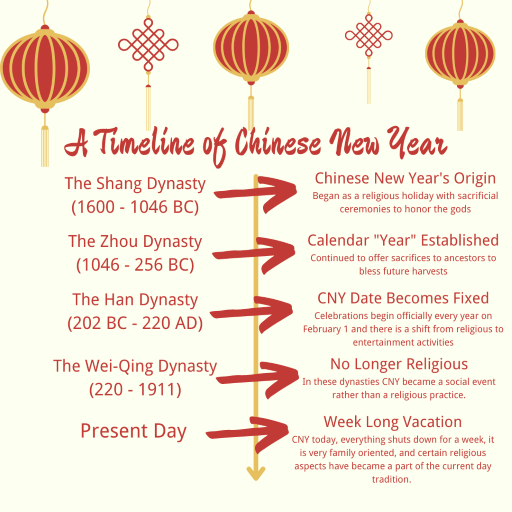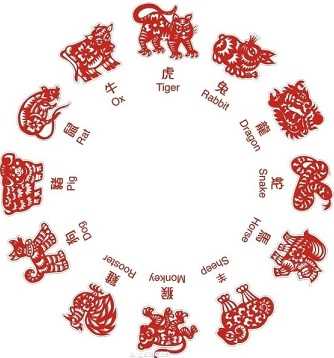A Brief History of the Chinese New Year
January 27, 2022

By: Kaysey A. Richardson
Happy Chinese New Year! Not sure what that means? Chinese New Year, also referred to as the Lunar New Year or the Spring Festival, is one of the most important traditional Chinese festivals and began around 3,500 years ago. This festivity is tied to the Chinese lunar calendar, and it originated as a time for feasting and to honor household and heavenly deities and ancestors. Although the Western calendar, which celebrates the new year on January 1, was adopted by China in 1912, it and many other countries continue to celebrate the Lunar New Year.
The Origin of the Lunar Calendar and Nian, the “Yearly Beast”
The earliest recorded form of the ancient Chinese lunar calendar can be seen in the 14th century B.C. during the reign of the Shang Dynasty. The calendar operated as a religious, dynastic, and social guide and changed structure according to which emperor held power. The intricate calendar’s parameters were set according to the lunar phases and solar solstices and equinoxes. The Chinese New Year traditionally began with the new moon which occurs between the end of January and the end of February and lasts about 15 days or until the full moon arrives.
The early recordings of the Chinese New Year included sacrificial ceremonies in honor of gods and ancestors at the end of each year. This ritual, like many old traditions, was steeped with stories and myths. The most popular of these being the story of the mythical beast Nianshou (Nian). Nianshou, meaning the “yearly beast,” arrived every eve of the new year to eat livestock, crops, and even the occasional person. To prevent this beast from causing destruction, people would put food outside of their doors for Nian.
According to the story, some people’s fear of Nian caused them to flee into remote mountains to avoid the terror of the monster. People lived in fear of the monster until one day when “an old man with white hair and a ruddy complexion visited a village.” The man said they no longer had to live in fear because he figured out that Nian was scared of the color red and loud noises. After discovering this information, the monster never showed up again, and thus began the tradition of red lanterns, red clothing, and cracking bamboo (an early form of firecrackers).
Fun fact: the term “Nian” referring to the word “year” did not show up until hundreds of years after the story of the Nianshou. The word for year literally came from a monster.
The Chinese Calendar “Year” was established during the Zhou Dynasty (1046-256 BC) and became a custom in this dynasty to offer sacrifices to ancestors or gods and worship nature to bless future harvests. By the Han Dynasty (202 BC-220 AD), the date of the festival changed. Rather than beginning with the new moon, China began their new year on the fixed date of February 1 every year.
By the Wei and Jin Dynasties (220-420) the festivities of celebrating the new year began to move from worshiping gods and ancestors to a form of entertainment. Families began to get together to clean their house, have a feast, and stay up late until the new year. As time went on and China experienced prosperity of economies and cultures during the Tang, Song, and Qing Dynasties (960-1911), customs became more similar to modern times. Those customs included setting off firecrackers, visiting relatives and friends, and eating dumplings. Various forms of entertainment were enjoyed as well, such as watching dragon and lion dances and lantern shows. During these dynasties, this celebration was named the Spring Festival and celebrations shifted from religious revels to entertaining and social festivities.
In 1912, the government abolished Chinese New Year and the lunar new year and adopted the Gregorian calendar which made January 1 the official start of the new year. In 1949, under the reign of the Chinese Communist Party leader, Mao Zedong, the government outlawed the celebration of the traditional Chinese New Year. At the end of the 20th century, Chinese leaders became more willing to accept the Chinese tradition. In 1996, China instituted a weeklong vacation during the holiday which took the name of the Spring Festival. During this week businesses come to a halt and people are given the chance to travel home and celebrate the new year with their family.
Chinese New Year Traditions:
Although China adopted new and more modern traditions over the years, such as online shopping and a Spring Festival Gala, most traditions stem back thousands of years. One such tradition being the use of red lanterns and firecrackers from the Nian. Another tradition that remains in these festivities is the exchanging of red envelopes that are filled with money.This is derived from yet another ancient monster demon, the Sui, who would terrify children while they were asleep. Elders began to give out red envelopes of coins to children for them to play with and keep them awake throughout the night.
To prepare for the holiday, houses are cleaned thoroughly to rid them of “huiqi” or bad luck from the old year. Ritual sacrifices of food and paper icons are offered to ancestors, and scrolls printed with lucky messages are posted on the front of household gates. Many elders give out money to children, and fireworks are set off throughout the celebration. Being the biggest event, the Lantern Festival takes place on the last day of the festivities.
On New Year’s Eve, extended family members gather around a table for a meal that includes fish as the last course, symbolizing abundance. While the fish is the last dish served, it is actually not meant to be eaten because of its meaning of abundance. Long noodles are eaten in the first five days of the New Year, which symbolizes a long life. Finally, on the fifteenth day of the New Year, round dumplings shaped like the full moon are shared as a symbol of the family unit and perfection.
2022: The Year of the Tiger
Even though the holiday is now celebrated for entertainment rather than religious value, the religious symbols are still respected, with the most important symbol being the zodiac animals. The lunar years each bear the name of a different creature, and there are exactly twelve of them. Just like the ancient tale of the Nain monster, the legend of the animal zodiacs has created a tradition that remains important in Chinese culture to this day.
According to the tale, the Jade Emperor, a significant god in traditional Chinese religion, invited all the animals in the world to take part in a race. Only twelve species turned up: a pig, dog, rooster, monkey, sheep, horse, snake, dragon, rabbit, tiger, ox, and rat. As a reward for showing up to their race, the Jade Emperor named a year in the zodiac after each one and the outcome of the race would be the determining factor in which each animal would be placed. Here is the outcome of the race and the order of the zodiac animals:
| 1. Rat | 5. Dragon | 9. Monkey |
| 2. Ox | 6. Snake | 10. Rooster |
| 3. Tiger | 7. Horse | 11. Pig |
| 4. Rabbit | 8. Sheep | 12. Dog |

Fun Fact: Have you ever noticed how prevalent the cat is in Chinese culture, but it isn’t one of the twelve zodiac animals? The rat is to thank for this, because, according to the legend, the cat asked the rat to wake it up for the race, because like most cats, it had a habit of sleeping in. The rat was so excited about the race, and it forgot to wake the cat! Therefore, there is no cat zodiac.
To read the full story of the legend of the race click here
Like other forms of astrology, the animal zodiac in Chinese practice represents how others perceive you or how you present yourself. Depending on the year you are born, your personality traits will reflect that of your animal zodiac. Similar to having a full astrology chart, there are animals that are assigned by month (inner animals), by day (true animals), and hours (secret animals). This year is the year of the tiger and according to Chinese astrology—be wary of the year you are born in because that is supposed to be the unluckiest year for you. So anybody previously born in the year of the tiger—2022 might not be your year!
References and Further Reading: